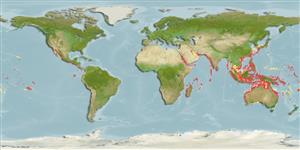Bivalvia |
Ostreida |
Isognomonidae
Environment: milieu / climate zone / depth range / distribution range
Ecology
Benthic, usually 0 - 25 m (Ref. 75831). Tropical
Indo-Pacific.
Length at first maturity / Size / Weight / Age
Maturity: Lm ? range ? - ? cm
Intertidal to subtidal, attached to the undersides of boulders. Also found in mussel aggregations, corals heads, and on pilings (Ref. 75840). Reported from Hong Kong to be found on the ceilings and walls of submarine caves (Ref. 126058).
Life cycle and mating behavior
Maturity | Reproduction | Spawning | Eggs | Fecundity | Larvae
Members of the class Bivalvia are mostly gonochoric, some are protandric hermaphrodites. Life cycle: Embryos develop into free-swimming trocophore larvae, succeeded by the bivalve veliger, resembling a miniature clam.
Taylor, J.D. and E.A. Glover 2004 Diversity and distribution of subtidal benthic molluscs from the Dampier Archipelago, Western Australia; results of the 1999 drege survey (DA2/99). Records of the Western Australian Supplement 66:247-291. (Ref. 8021)
IUCN Red List Status
(Ref. 130435: Version 2025-1)
CITES status (Ref. 108899)
Not Evaluated
Not Evaluated
Threat to humans
Harmless
Human uses
| FishSource |
Tools
More information
Trophic EcologyFood items (preys)Diet compositionFood consumptionPredators Population dynamicsGrowth
Max. ages / sizes
Length-weight rel.
Length-length rel.
Length-frequencies
Mass conversion
Abundance
Life cycleReproductionMaturityFecunditySpawningEggsEgg developmentLarvae PhysiologyOxygen consumption
Human RelatedStamps, coins, misc.
Internet sources
Estimates based on models
Preferred temperature
(Ref.
115969): 21.7 - 29.1, mean 27.7 (based on 1588 cells).
